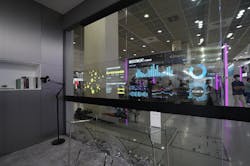This article originally appeared in the February 2023 issue of Security Business magazine. When sharing, don’t forget to mention Security Business magazine on LinkedIn and @SecBusinessMag on Twitter.
The goal of modern security operation centers (SOCs) is to leverage the latest AV and IT technologies – many of which were found on the show floor at CES 2023 – to provide true situational awareness that enables critical decision making in real time.
The amount of data these centers must manage and monitor is constantly growing, so a robust technology infrastructure is required to ensure easy access and analysis of real-time information that can be shared quickly with minimal confusion or complications across disparate systems, networks, sites or users.
A key element of many SOCs are the advanced displays, with technology such as OLED, that enable the visualization of disparate sources and information streams to display side by side. When these advanced display systems are combined with a robust IT source management solution and augmented with AI and API integrations, operators within the SOC are empowered to rapidly identify and monitor threats or vulnerabilities while minimizing risks and enabling early intervention.
Today, centralized software-as-a-service (SaaS) platforms can manage visual services in combination with any required source material: Varied data, IoT and AI inputs, video feeds, and more, helping to optimize workflows and simplify critical communications with internal and external stakeholders. The best solutions allow virtually any number of sources to be broadcast to any number of displays, with multiple feeds on a single display, or any custom configuration that is required.
Data Visualization Equals Fast Responses
During an incident, control room operators can determine and enact the next level of action based on triggers from AI-enhanced software. ForAs SOCs increase the number of input streams, data sources and software solutions they use or monitor, modernized AV-over-IP solutions make it possible to take proactive approaches with immediate access to all available information and the ability to share quickly with on-site and remote teams.
Such solutions enable digitally transformed enterprises to visualize IT-managed services from virtually anywhere. A solution that is built on standard IT protocols for the aggregation, distribution and management of AV and IoT sources provides integrators and end-users a powerful, streamlined display network management experience that puts available information at their fingertips – whether it is providing video and data through real-time streaming protocols (RTSP) for control rooms or managing 8K content across hundreds of displays.
Information can be fed to a center’s digital displays from virtually any number of sources, including control, alarm or HVAC systems, live surveillance cameras, environmental sensors and more. The most robust visual management systems then allow all the info to be shared externally with first responder agencies or stakeholders.
In a SOC environment such as one found at a university, the end-user may want to provide local police or fire agencies with the ability to access critical information from within the university SOC. By deploying a software-defined video wall platform, all that is needed is a connected display and/or access to a HTML 5 enabled browser that is connected to the LAN directly or via VPN to view real-time information that is broadcast from the SOC.
Future-Proofing Increases Reliability and Lowers Costs
As with any technology-heavy space, the specific components and organization of SOCs can vary widely. A new generation of advanced video wall and commercial large format displays that leverage intelligent software solutions are poised to help improve performance, reduce costs, save energy, and simplify installation and long-term maintenance. Consolidated display and software solutions can help reduce the total number of components required, which helps simplify designs and can reduce total energy use.
Knowing that these monitoring systems must exhibit bulletproof reliability for uninterrupted 24/7 operation, it is vital to deploy commercial grade displays that maximize visual performance, longevity and interoperability.
Another key factor in ongoing operations is whether technology is proprietary and how easy it is to integrate with future components or systems. By relying on non-proprietary systems with powerful APIs, operators can better prepare for and manage equipment upgrades and expansions, further reducing costs and reducing complexity to deliver greater value and usability.
Chris Feldman is Senior Business Development Manager for LG Business Solutions USA; Shane Vega is VP Product Marketing for Userful.
About the Author
Chris Feldman
Chris Feldman is Senior Business Development Manager for LG Business Solutions USA.
Shane Vega
Shane Vega is VP of Product Marketing for Userful

